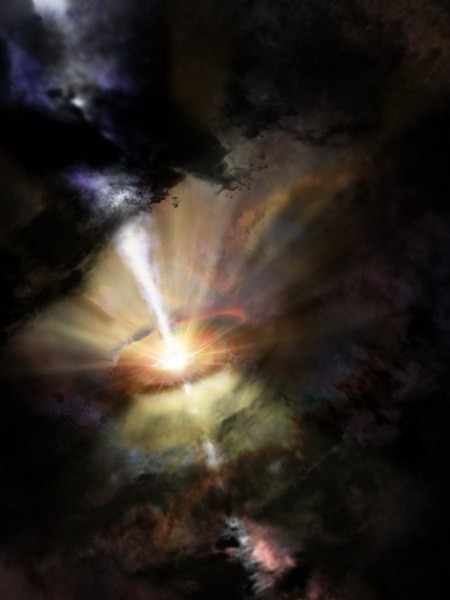Monster Supermassive Black Hole Feeds on Chaotic Galactic 'Rain'
| Ana Verayo | | Jun 09, 2016 05:50 AM EDT |
(Photo : NRAO/AUI/NSF; Dana Berry / SkyWorks; ALMA (ESO/NAOJ/NRAO)) Deep in the heart of the Abell 2597 Brightest Cluster Galaxy, astronomers see a small cluster of giant gas clouds raining in on the central black hole
Astronomers just detected a supermassive black hole located in the center of a cluster of galaxies, about 1 billion light years away, which appears to a colossal creature devouring on some cosmic gas clouds.
Researchers of the Atacama Large Millimeter/submillimeter Array (ALMA) observatory captured this black hole in action, as this process is known as accretion, which is a method where black holes collect more mass, appearing to snack on some cold cosmic gas clouds.
Like Us on Facebook
Past studies suggested how the majority of supermassive black holes were believed to ingest on hot gas clouds made from ionized particles that emanate from the halo around the core of these galaxies. However, these new observations reveal that this cluster of galaxies known as Abell 2597 Brightest Cluster Galaxy appears to be consuming some cold gas clouds that have been formed or coagulated once more from past cosmic feasts.
According to astronomer Grant Tremblay of Yale University, this violent and even chaotic accretion among black holes and galaxies have been a major theory, predicting that this process is how black holes reach their current sizes. However, in this new study, this is one of the first observational evidences of a chaotic, cosmic "rain" that feeds this supermassive black hole.
Apart from obtaining evidence of this cold gas accretion in black holes, this study also marks the first time that any type of galactic "rain" that has been seen, as cold matter continuously drops into the region of the black hole in clumps as opposed to a steady stream of gas.
These cosmic, chaotic clouds are so massive that they are estimated to reach 10 light years across, as this space weather travels around 670,000 miles per hour, making this more violent than hurricanes observed on Earth and even the solar system.
Researchers now believe that these new findings can provide more clues if this alternate type of black hole feeding frenzy is more common in the universe than first thought.
This new study is published in the journal Nature.
Tagssupermassive black hole, Black Holes, black hole feeding, galactic rain, black holes cold gas clouds
©2015 Chinatopix All rights reserved. Do not reproduce without permission
EDITOR'S PICKS
-

Did the Trump administration just announce plans for a trade war with ‘hostile’ China and Russia?
-

US Senate passes Taiwan travel bill slammed by China
-

As Yan Sihong’s family grieves, here are other Chinese students who went missing abroad. Some have never been found
-

Beijing blasts Western critics who ‘smear China’ with the term sharp power
-

China Envoy Seeks to Defuse Tensions With U.S. as a Trade War Brews
-

Singapore's Deputy PM Provides Bitcoin Vote of Confidence Amid China's Blanket Bans
-

China warns investors over risks in overseas virtual currency trading
-

Chinese government most trustworthy: survey
-

Kashima Antlers On Course For Back-To-Back Titles
MOST POPULAR
LATEST NEWS
Zhou Yongkang: China's Former Security Chief Sentenced to Life in Prison

China's former Chief of the Ministry of Public Security, Zhou Yongkang, has been given a life sentence after he was found guilty of abusing his office, bribery and deliberately ... Full Article
TRENDING STORY

China Pork Prices Expected to Stabilize As The Supplies Recover

Elephone P9000 Smartphone is now on Sale on Amazon India

There's a Big Chance Cliffhangers Won't Still Be Resolved When Grey's Anatomy Season 13 Returns

Supreme Court Ruled on Samsung vs Apple Dispute for Patent Infringement

Microsoft Surface Pro 5 Rumors and Release Date: What is the Latest?










